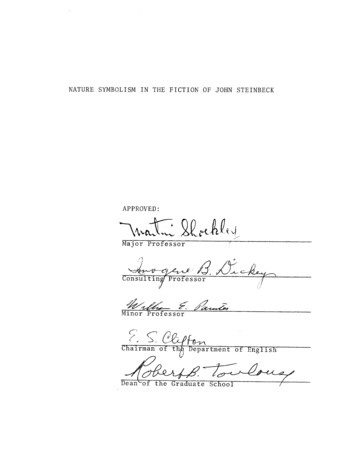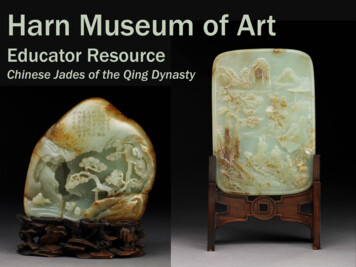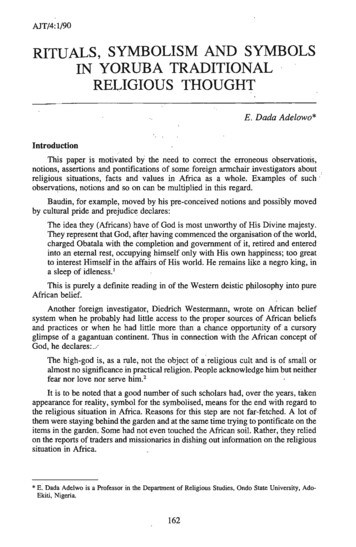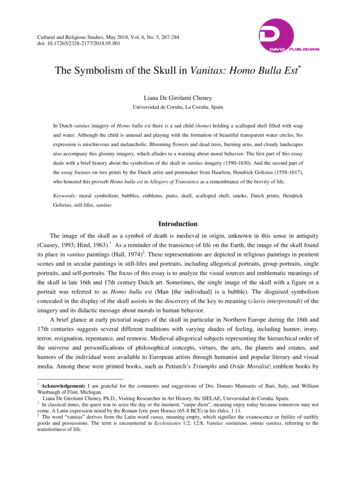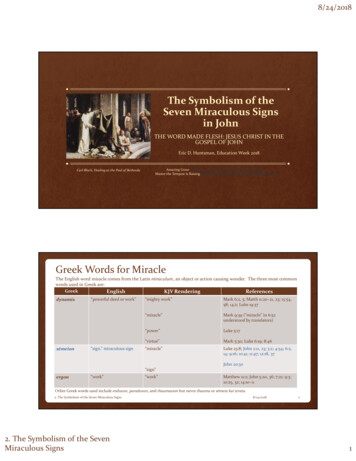
Transcription
8/24/2018The Symbolism of theSeven Miraculous Signsin JohnTHE WORD MADE FLESH: JESUS CHRIST IN THEGOSPEL OF JOHNEric D. Huntsman, Education Week 2018Carl Bloch, Healing at the Pool of BethesdaAmazing Grace https://www.youtube.com/watch?v C2arm5ydeJcMaster the Tempest Is Raising https://www.youtube.com/watch?v Ef2xgL45qX4Greek Words for MiracleThe English word miracle comes from the Latin miraculum, an object or action causing wonder. The three most commonwords used in Greek are:GreekEnglishKJV RenderingReferencesdynamissēmeion“powerful deed or work”“sign,” miraculous sign“mighty work”Mark 6:2, 5; Matth 11:20–21, 23; 13:54,58; 14:2; Luke 19:37“miracle”Mark 9:39 (“miracle” in 6:52understood by translators)“power”Luke 5:17“virtue”Mark 5:30; Luke 6:19; 8:46“miracle”Luke 23:8; John 2:11, 23; 3:2; 4:54; 6:2,14; 9:16; 10:41; 11:47; 12:18, 37John 20:30“sign”ergon“work”“work”Matthew 11:2; John 5:20, 36; 7:21; 9:3;10:25, 32; 14:10–11Other Greek words used include endoxon, paradoxon, and thaumasion but never thauma or sēmeia kai terata.2. The Symbolism of the Seven Miraculous Signs2. The Symbolism of the SevenMiraculous Signs8/24/201821
8/24/2018Gospel Portrayals of Miracles Mark (19 stories; 4 summaries; 1 report): Miracles as powerful deeds (dynameis) are the signs thatJesus is the Son of God Miracles, rather than explicit teachings, open Jesus’ ministry (see Mark 1:21–45) Marcan miracles are described in detail and very dramatically (remember this is the “Harry Potter gospel!”) Matthew (21 stories; 10 summaries; 4 reports): Miracles are secondary to Jesus’ authoritative teaching With the exception of a passing summary of healings (Matt 4:23–24), mention of specific miracles (Matt 8:1–17) isdelayed until after the Sermon on the Mount (Matt 5–7) Miracles are not portrayed so magically . . . Luke (21 stories; 4 summaries; 4 reports): Authoritative teaching and miraculous deeds are balanced Luke 4:16–30, esp. vv. 18–19 ( Isaiah 61:1–2) Luke adds miracles that bless women; also more medically interesting miracles John (7 1 signs): Seven specific signs (sēmeia) reveal who Jesus is and whathe has come to do “that ye might believe that Jesus is the Christ, the Son ofGod; and that believing ye might have life through his name” (John 20:31)2. The Symbolism of the Seven Miraculous Signs8/24/20183Miracles and Their Symbolism Power over the elements Revealing the divine identity of Jesus Healing the sick Reflecting the healing, strengthening, and purifying power of the atonement Casting out devils [none in John] Liberating those who are enslaved to forces beyond themselves Causing the blind to see and the deaf to hear Opening spiritual eyes and ears Raising the Dead Overcoming spiritual as well as physical death while pointing to a more eternal kind of life2. The Symbolism of the Seven Miraculous Signs2. The Symbolism of the SevenMiraculous Signs8/24/201842
8/24/2018Sēmeia: Miraculous Signs and Enacted Signs Σημεῖον (sēmeion): a sign token, a representative symbol; a portent or sign thatsignifies something greater Miraculous signs: miracles that reflect or reveal something greater than the act itself Enacted Signs: prophetic actions “Now when he was in Jerusalem at the passover, in the feast day, many believed in his name, whenthey saw the miracles which he did. (John 2:23; cf. 2:23; 3:2 ) At this point, Jesus had changed water to wine at Cana (the first miraculous sign) but had not performedany recorded miracles in Jerusalem He had cleansed the temple—a symbolic act or “enacted sign” Isaiah walked naked and barefoot for three years! (Isaiah 20:2–6) Ezekiel could not mourn for his wife, built a model of Jerusalem, and baked symbolic bread (Ezekiel 4:1–17; 24:15–25) Being lifted up (John 3:14; 8:28; 12:32, 34; 19:18) Blood and water from his side (John 19:34–35)2. The Symbolism of the Seven Miraculous Signs8/24/20185Miraculous Signs in John Seven Important “Signs” 1 ‐ Water into Wine (2:1–11) 2 ‐ Healing of Nobleman’s Son (4:46–54) 3 ‐ Healing of the Lame Man at the Pool of Bethesda (5:1–18) 4 ‐ Feeding of the 5,000 (6:1–15) 5 ‐ Walking on Water (6:16–21) 6 ‐ Healing of the Man Born Blind (9:1–41) 7 ‐ Raising of Lazarus (11:1–57) The greatest sign, the resurrection of Jesus! Also, an astonishing catch of 153 fish after the Resurrection (John 21:14–14)2. the Seven Miraculous Signs in John2. The Symbolism of the SevenMiraculous Signs8/24/201863
8/24/2018Structure of John Prologue (John 1:1–51) Logos Hymn (John 1:1–18) The First Witnesses and Disciples (1:19–51) Book of Signs (John 2:1–12:50) First Signs and Dialogues (John 2:1–4:54)Signs and Discourses in the Context of Jewish Feasts (John 5:1–10:42)The Raising of Lazarus (John 11:1–54)The Book of Signs Closes: Setting the Scene for the Passion (John 12:11–12:50) Book of Glory (John 13:1–20:31) The Last Supper (John 13:1–38)The Farewell Discourses (John 14:1–17:26)Crucifixion, Death, and Burial (John 18:1–19:42)Resurrection (John 20:1–31) Epilogue (John 21:1–25)17a. John the Theologian8/24/201878/24/20188The First Sign: Water to Wine Symbolism of 6 stone waterpots Old law of Moses (6, imperfect)contrasted with new law of Christ Sacramental imagery Creator symbolism YHWH creates/organizes, Jesusre‐creates/re‐organizes Incarnational theology Water: divinity, spirit, eternalnature Blood/wine: mortality, flesh,physical/fallen nature Presence of Mary―the means ofIncarnation2. the Seven Miraculous Signs in John2. The Symbolism of the SevenMiraculous Signs4
8/24/2018The Second Sign: Healing theNobleman’s Son (miracle story, 4:46–54) Jesus Returns to Galilee (narrative transition report,4:43–45) “So Jesus came again into Cana of Galilee, where he madethe water wine. “Cana” reference completes the ring begun with chapter2 Water made wine Word made flesh Second Sign: Healing the Nobleman's Son in Cana(miracle story, 4:46–54) Healing Power of the Incarnate Word provides segueto the healing of the lame man2. the Seven Miraculous Signs in John8/24/201898/24/201810Jesus at the Pool of Bethesda Jesus goes to Jerusalem for a feast, which is not named(and the emphasis will be on the weekly festival ofSabbath rather than a particular annual festival) “Now there is at Jerusalem by the sheep market a pool,which is called in the Hebrew tongue Bethesda,having five porches” (5:2) bêt ḥeseda or “House of Mercy” “In these lay a great multitude of impotent folk, ofblind, halt, withered, waiting for the moving of thewater. (5:3) “ . . . darkness was upon the face of the deep. And theSpirit of God moved upon the face of the waters” (Genesis1:2)19. Jesus and the Feasts of the Jews 1 (John 5–6)2. The Symbolism of the SevenMiraculous Signs5
8/24/2018Jesus Heals the Infirm Man at BethesdaAnticipated by the Healing the Nobleman’s Son in Cana: Jehovah creates, Jesus re‐creates/heals 5:4 with its story of the angel troubling thewater is missing from the earliest and bestGreek mss. “And a certain man was there, which had aninfirmity thirty and eight years” (5:5) 38 years: the period of time that Israel wanderedbetween Kadesh‐barnea and Wadi Zereb(Deuteronomy 2:14) 40 years is symbolic of the time of our mortalprobation For most of that time we are in a state ofrebellion and sin Jesus comes to him: “Rise [egeire], take up thybed, and walk” (5:8)Bartolomé Esteban Murillo, Christ at the Pool of Bethsesda egeire, the word used for “rise” is also used forresurrect!19. Jesus and the Feasts of the Jews 1 (John 5–6)8/24/2018118/24/201812Feeding of the 5,000 (6:5–15) Because John is independent of Mark, these twocounts provide “multiple attestation of sources”(since presumably Matthew and Luke were drawingupon Mark) John’s detail that there were 5 barley loaves connects Jesus’ miracle with that of Elisha, who fed 100men with 20 barley loaves (2 Kings 4:42–44) “Then those men, when they had seen the miracle(sēmeion) that Jesus did, said, This is of a truth thatprophet that should come into the world” (6:14) “When Jesus therefore perceived that they wouldcome and take him by force, to make him a king, hedeparted again into a mountain himself alone (6:15)19. Jesus and the Feasts of the Jews 1 (John 5–6)2. The Symbolism of the SevenMiraculous Signs6
8/24/2018Walking on Water (6:16–21) “It is I [egō eimi]” (6:20) egō eimi the Hebrew ‘ehyeh ‘ašer ‘ehyeh, or “I Amthat I Am,” by which YHWH revealed himself to Moses(see Exodus 3:14) Jesus’ epiphany on the Sea of Galilee resonateswith other powerful Old Testament revelations ofJehovah (see Job 9:8, 38:16; Habakkuk 3:15) As Bertil Gärtner writes, “Just as the Lord ploughed apath for Israel through the sea, leading them tofreedom from bondage, so Jesus, when he walks on thewater, shows that as Messiah he has power over theseas.”Ivan Aivazovsky, Christ Walks on Water (although this is clearly depicting the Matthean miracle, because it has Peter walkingout to meet Jesus!)19. Jesus and the Feasts of the Jews 1 (John 5–6)8/24/201813Feast of Tabernacles Sukkôt: “booths, tabernacles, or temporary shelters” Commemorated the wanderings of the Children of Israel in the wilderness One of the three pilgrimage festivals, during Sukkot worshipers filledJerusalem modern observant Jews still live, eat, and study in a sukkah during thisfestival Later also celebrated as an autumn harvest festival Celebrated by waving palm, willow and leafy branches together with acitrus fruit The time when the king was anointed, some of its imagery will beadopted for Jesus’ triumphal entry Sukkot at the Western Wall in Jerusalem:http://www.youtube.com/watch?v IOTxfETVsmo&feature player detailpage Second Temple Sukkot rituals of pouring water and lighting lightsset the context for Christ’s discourses on His being the source ofliving waters and light 17. John 7‐122. The Symbolism of the SevenMiraculous SignsSee Andy Skinner’s discussion at https://www.youtube.com/watch?v qYWTReAN87w8/24/2018147
8/24/2018Tabernacles and LightGreat lamps were lit in the temple courts each night Discourse on the Light of the World (8:12–59; Sukkot and Light) Physical and Spiritual Blindness (9:1–41; More on Jesus as Light)17. John 7‐128/24/2018158/24/201816Physical and Spiritual Blindness(9:1–41; more on Jesus as Light) Sixth Sign: Healing of the Man Born Blind (9:1–12) clay/spittle dust/water‐breath‐spirit! (cf. Gen 2:7) Pool of Siloam: Siloaḥ means “sent” Washing away blindness Baptism is the means of applying the re‐creating power of theAtonement? https://www.youtube.com/watch?v Yk24nA4pI80 Pharisees Persecute the Blind Man (9:13–34) Jesus and the Blind Man (9:35–38) Jesus Condemns Spiritual Blindness (9:39–41) “Jesus said unto them, If ye were blind, ye should have no sin: but nowye say, We see; therefore your sin remaineth.” (9:41)17. John 7‐122. The Symbolism of the SevenMiraculous Signs8
8/24/2018The Lazarus Cycle (John 11:1–12:11) Threat to Lazarus: his fatal sickness (11:1–16) Martha and Jesus: her confession (11:17–27) Belief of some of the “Jews” that came to Maryand the unbelief of others (11:28–37) Raising of Lazarus (11:38–44) Unbelief of some of the “Jews” that came toMary and the belief of others (11:45–57) Mary and Jesus: her act of anointing (12:1–8) Threat to Lazarus: leaders of “the Jews” plot againsthim (12:9–11)20. Jesus and the Feasts of the Jews 2; Lazarus (John 7–12)8/24/201817Jesus the Resurrection and the Life (11:17–27) Jesus the Resurrection and the Life (11:17–27) “Many of the Jews came to Mary and Martha to comfort them” (11:19,one of the few neutral uses of the term) When Martha speaks in faith, Jesus responds with teaching andtestimony Not just an anticipation of Jesus’ own resurrection but asymbol of how all need to be raised from spiritual death Jesus Mourns with Mary (11:28–37) When Mary weeps, Christ responds with compassion Seventh Sign: Jesus raises Lazarus from the dead(11:38–44) “And he that was dead came forth, bound hand and foot withgraveclothes: and his face was bound about with a napkin[soudarion]. Jesus saith unto them, Loose him, and let him go.”(11:44) soudarion is the same word used in 20:7 Jesus leaves his facecloth and graveclothes in the tomb because he will notneed them again!20. Jesus and the Feasts of the Jews 2; Lazarus (John 7–12)2. The Symbolism of the SevenMiraculous SignsKirk Richards, Raising Lazarus8/24/2018189
8/24/2018 2. The Symbolism of the Seven Miraculous Signs 5 Jesus Returns to Galilee (narrative transition report, 4:43-45) "So Jesus came again into Cana of Galilee, where he made the water wine. "Cana" reference completes the ring begun with chapter 2 Water made wine Word made flesh Second Sign: Healing the Nobleman's Son in Cana


